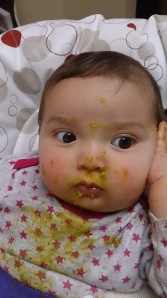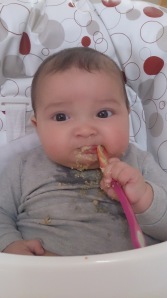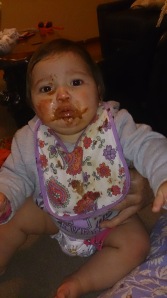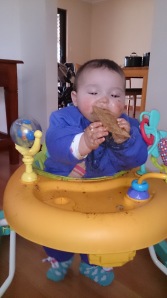Introducing solids has always been, hands down, my favourite part about the baby stage. As you can tell, I LOVE food, and being able to give it to my girls and share in their enjoyment is amazing. Sometimes I take for granted that I was taught from a medical perspective how to introduce solids to an baby, something that really isn’t taught elsewhere and results in mums doing frantic google searches and getting different advice from everywhere.
I wrote about this on my personal blog quite some time ago and good really good responses from mums that I had reached so what better place to re-post it (better written of course) for all you lovely ladies reading along.
This guide is a combination of what I was taught at university, what I have seen/heard through working as a dietitian and what I have experienced myself as a mum. My experiences may be different to yours but always remember to let your child be the guide and progress at their pace. So here we go, you ready for some fun??
The technical stuff
We start our kiddies on solids somewhere between 4 and 6 months. Don’t try to research the recommendations because the jury is out on an actual recommended time. Typically, health peak bodies all say different things. The World Health Organisation recommend starting solids from 6 months, whereas ASCIA (the main allergy body in Australia) say that there is not enough evidence to definitively say when but that experts around the globe say somewhere between 4 and 6 months. What they can all agree on is that your child’s signs of readiness should guide you.
Look for:
The ability to sit supported with good head control.
Your little one doesn’t need to be able to sit by themselves but they do need to be able to sit upright without slumping to the side, air-o-planing off the side of the high chair, face planting their pumpkin or licking their chest.
An interest in food.
Please, please, PLEASE look for this one. One way to fail yourselves right from the start mummies, is to start before your darling is ready. Forget about “such-and-such” at mum’s group who is bragging about whatever-her-bubs-name eating three meals a day, licking the bowl and asking for more. Not your child, not your problem. You will be banging your head against a brick wall if you try before your bubba is ready. Don’t feel bad if you do try and bubs doesn’t want a bar of it, you haven’t caused any harm. Just wait a few weeks and try again. NO stress.
What does an interest in food look like?
Our girls would stalk our mouthfuls. They would watch your fork get the food, watch the food to your mouth, then watch it disappear into your mouth. Over and over again. If you feel like a prisoner with a chubby bully watching you eating and waiting till you turn your back to knock you out and steal your food then you have food interest. Number 2 bub even started chewing thin air as she watched us chew. It can also take the form of children putting things in their mouth all the time, and/or grabbing at your food.
How to start
In terms of allergy prevention, ASCIA say that there is “little evidence that delaying introduction of solids beyond 6 months reduces allergy risk” and “insufficient evidence to support previous advice to specifically delay or avoid potentially allergenic foods (such as egg, peanuts, nuts, wheat, cow’s milk and fish) for the prevention of food allergy or eczema”. What does that mean? It means that the old idea of introducing foods at different ages isn’t actually supported by much evidence. So in theory you can start with whatever food you like.
There are however a few disclaimers:
– You want to maintain some element of safety, so you might not give your little one a big ol’ lump of steak or raw carrot. If you want to start with meat try minced, cooked then pureed. Or if you want to do baby led weaning then try some slow cooked meat or mince (there are precautions you should take if you want to do baby led weaning (BLW). Contrary to popular skeptical belief, BLW doesn’t mean handing your child any type or form of food you like. There are guidelines, follow them here).
-If your child has a diagnosed allergy (and by this I mean true allergy, tested by an allergist. Not diarrhoea sometimes, or a rash sometimes or “tested” by a blood test or by some weird technique like hair analysis or holding onto metal poles) or you have allergy in your family, it might be worth waiting on certain foods. If this is the case, consult an allergist or a dietitian who specialises in allergy to help decided what to start with and what precautions to take.
And there are some common sense ideas that generally work well too:
– Offer food after a feed to begin with, in the early stages food is an addition to milk not the other way round. By the time they have been eating solids for a few months and are managing “meals” i.e about ½ cup at a sitting, you could start switching it round.
– Start with bland tastes, rice cereal, porridge etc. Babies are super tasters and will get much more taste from a mouthful that we do so bland to start is okay.
– If you are concerned about reactions, start each new food by itself for one sitting before using it with others that are okay.
– Introduce foods that are like the family foods you normally eat. I.e if you normally have peas, potato and carrot as your veggies then start with these ones, if your family favourite meal is spaghetti bolognaise, use this as a minced option. Don’t go making a million different meals that put more stress on you.
It’s all in the texture
Texture is a big thing for babies and babies’ mouth development. If you aren’t following baby led weaning, then you will probably be starting with purees. Don’t fall into the trap of thinking babies have purees for ages. They don’t need them for much longer than a few weeks before you can start lumping up the texture.
So also, as a side note, don’t get sucked into the “baby food preparation all-in-one, miracle saviour” machines that will set you back a pineapple or two. Considering that bubs will only be on puree for a few weeks, get yourself a stick blender for $20 or less at the supermarket and you have all you need (plus they have a freaking million other uses for that matter I LOVE my stick blender).
After puree, you can go to small lumps. If you are making it yourself this is easy to grade, just blend it less and less as time goes on, until you get to fork mashed and then minced consistency. If you are buying your baby food, get something more lumpy (like the 8 month plus) jars/sachets and use your trusty old stick blender (or a fork really) to make it less lumpy.
The dreaded choke
When it comes to moving up through the textures, the biggest concern for mummies is fear of choking. That shit is rife out there! However, it is a moment in your mummy lives where you have to suck it up, prepare yourself, and let your bubba learn.
So by this I mean:
-suck it up. Okay your fear is real, I get that. Your kids are your LIFE. But they do need to learn how to eat, chew and swallow. And if they get puree their whole lives, they become less and less able to learn to chew and swallow. Your child will gag. They will cough and splutter. And god forbid, they may even choke properly. But again, it’s something they have to do to learn.
-prepare yourself. LEARN FIRST AID. If you can’t afford a course, google how to clear your baby’s throat if they choke. Do this before you start solids. Not while your baby is choking. Learn the real signs of choking (no air going in or out, silence, colour of their face going red to blue) and be bloody vigilant. Don’t ever leave your baby (or toddler near a baby) with food if you aren’t there. Especially because the real signs of choking are silent. How are you supposed to know if you aren’t there?! Don’t start a meal with them if you can’t be there the whole time.
-let your bubba learn. If they gag, cough or splutter try really really hard not to swoop in there straight away and get the food out. Two reasons for this:
1) they need to learn how to move their mouth to clear their throat if they are about to choke. This will mean less gagging over time; and
2) if you swoop in as soon as they gag or splutter you could actually scare them into inhaling the contents of their mouth properly and then they really will be choking. Not to mention they will start to associate anxiety with gagging/etc so will actually increase their chance of choking continually. So, if they gag/cough/splutter, let them go for a little bit. If they are coughing, then air is getting into the lungs and they are just getting the food cleared out of their throat. They are learning. If they go silent, no sounds, no air, no cough – complete permission to get in there and perform the necessary procedure!
How much to give
Well how much is a piece of string? As usual, every child is different. Some may be small eaters and some may be gobblers.
To start, your baby will probably have about 1 tsp at best. Progress with amounts as your child allows. When they turn their head away or get annoyed, they have had enough. Remember that their stomachs are about the size of their fist so don’t be expecting them to eat a dinner plate.
Once they get to “meal” stage, the World Health Organisation suggests this frequency as a guide:
6-8 months offer 2-3/day
9-11 months offer 3-4/day
12-24 months offer 3-4/day plus 1-2 snacks
*remember if you started solids earlier you may adjust the months accordingly.
Fussy eating
Okay here’s the big one. How to prevent fussy eating from starting. And let me say, it’s lucky you aren’t paying for this because it’s pretty basic. I could actually write a whole post on this but I’m giving you the most basic and successful tip that will hopefully set you up for success.
Okay, its one word. Relax. Relax relax RELAX! Obviously every kid is different, and I make no guarantees, but I can tell you now, the most successful way of preventing your baby from becoming fussy is to relax. Babies, toddlers and kids are fickle with food. That is a fact. One day they will eat their entire body weight in food and the next day they will turn their nose up at everything you try. They also love attention, and they don’t give a damn how they get it! If they twig that you care about how much they eat, they will hold onto that one thing they can control (especially if they are lovely independent little kiddies like my Miss 3).
If they aren’t interested (for whatever reason – not hungry, excited, at grandma’s house, friends over) then don’t push it. They won’t starve. If you have a normal healthy child, they won’t starve if they don’t eat a meal, let alone a few meals. Pleeeaaassseeee don’t fall into the trap of giving them something they like just so they don’t go to bed hungry. Kids are smart. They will soon realise that all they have to do is say they aren’t hungry/or just cry if they are a baby, to get something they want. Yup it can be bloody heartbreaking when you prepare meals for your kids and they turn up their noses but the best way is to calmly tell them that “it is fine, but I’m putting it in the fridge and if you tell me you are hungry later I can bring it out for you”.
So when starting solids, use this motto from the start. If bubs turns up their nose, don’t stress. They will still be getting plenty of nutrients from milk (whether breastfed or bottle fed) and they don’t need to get all their nutrients from food for a long time. Be relaxed and if they don’t want it then try again later. Try foods that are turned away, again, many times. It can take anywhere up to 10 times for a child to taste something before they like it. Same goes with textures. It will feel weird to them at first when you change textures. Give them time and don’t push it straight away.
Ideas, ideas, ideas
So you know about when, textures and safety. So now it’s time for the fail safe, tried and tested, recipes for success with getting your kids to eat everything served.
Hmmm they just don’t exist, I’m sorry that was cruel. It is all about trial and error. Every child is different and likes different things. And kids are generally pretty easy going when it comes to meals, meaning they don’t need gourmet masterpieces. Quick easy recipes normally go down much more easily (and it’s slightly less devastating if they refuse when you haven’t spent half the day cooking the meal). Cover the basic ‘kids food groups’, go foods (carbohydrates), grow foods (meat, dairy, nuts) and glow foods (fruit and veggies) in equal proportions, one third of each.
Here are some Jak starting solids faves: Please note – these are not amazingly inventive, just my girl’s favourites
Baby food
Obviously pureed veg and fruit. Pureed mince with added water to assist pureeing (which actually smells like cat food) was a favourite of Miss number 2.
Lumpy-minced consistency: risoni pasta with frozen veg (the stuff that is chopped really fine) and a jar of cheese sauce, tuna mornay, risoni bolognaise, scrambled eggs.
Finger foods: toast with vegemite, Cruskits with Vegemite, soft veggies, cheese slices, teddy bear pasta ($1 a packet at woolies!) or better yet I found Thomas pasta at Coles, shredded chicken, rice with frozen veg, home-made fish fingers, home-made chicken fingers,
So there you go, not ground breaking, super inventive or super-mum-esce. Just common sense.
Please hit me up with questions if you have them. I’m happy to answer!
Happy eating…
The Dietitian Mummy






Reblogged this on kellyafoster and commented:
Finally, someone explaining the introduction to solids is all about common sense, not what we mums sometimes feel pressured to do, because that’s how ‘they did it’. Thank you The Dietitian Mummy for providing your clear, expert advice on introducing solids. I honestly feel as though a massive weight has been lifted off my shoulders. I will definitely be passing this on to friends, and family – particularly those who feel my husband and I introduced solids too early (4 1/2 months). We followed our bubs signs and are happy we did so.
LikeLike
Thank you Kelly very kind words, that is my aim, to make life eaiser for mums and help them feel confident in their food choices 🙂
LikeLike